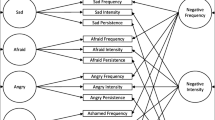Abstract
The shift of paradigm from psychodynamic therapy to behavior modification has changed the views of assessment and challenged traditional broad trait concepts. Behavioral assessment has used narrow, situation-specific trait tests, state self-report tests given in situations, and behavioral observations and performance ratings. Comparison of these types of measures are reported from a study of fear reactions in three situations. Narrow trait measures are generally more predictive of behavior than broad trait measures. State measures are even more predictive when given just before the performance. But only a sampling of such state measures can be used to define a trait because of the lower reliability of states. It is argued that behavior in situations is only predictable when an adequate number of behavioral samples is used.
Similar content being viewed by others
References
Borkovec, T. D., Weerts, T. C., & Bernstein, D. A. Assessment of anxiety. In A. R. Ciminero, K. S. Calhoun, & H. E. Adams (Eds),Handbook of behavioral assessment. New York: Wiley, 1977.
Ciminero, A. R. Behavioral assessment: An overview. In A. R. Ciminero, K. S. Calhoun, & H. E. Adams (Eds.),Handbook of behavioral assessment. New York: Wiley, 1977.
Cronbach, L. J. The two disciplines of scientific psychology.American Psychologist, 1957,12 671–684.
Endler, N. S., & Okada, M. A. A multidimensional measure of trait-anxiety: The S-R Inventory of General Trait Anxiousness.Journal of Consulting and Clinical Psychology 1975,43 319–329.
Endler, N. S., Hunt, J. McV., & Rosenstein, A. J. An S-R inventory of anxiousness.Psychological Monographs 1962,76 17(Whole No. 536).
Epstein, S. Traits are alive and well. In D. Magnuson & N. S. Endler (Eds.),Personality at the crossroads: Current issues in interactional psychology. Hillsdale, N.J.: Erlbaum, 1977.
Eysenck, H. J., & Eysenck, S. B. G.Eysenck personality inventory. San Diego: Educational and Industrial Testing Service, 1964.
Geer, J. H. The development of a scale to measure fear.Behaviour Research and Therapy 1965,3 45–53.
Goldfried, M. R., & Linehan, M. M. Basic issues in behavioral assessment. In A. R. Ciminero, K. S. Calhoun, & H. E. Adams (Eds.),Handbook of behavioral assessment. New York: Wiley, 1977.
Lang, P. J., & Lazovik, A. D. Experimental desensitization of a phobia.Journal of Abnormal and Social Psychology 1963,66 519–525.
McReynolds, W. T. Anxiety as fear: A behavioral approach to one emotion. In M. Zuckerman & C. D. Spielberger (Eds.),Emotions and anxiety: New concepts, methods and applications. Hillsdale, N.J.: Erlbaum, 1976.
Mellstrom, M., Jr., Cicala, G. A., & Zuckerman, M. General versus specific trait anxiety measures in the prediction of fear of snakes, heights, and darkness.Journal of Consulting and Clinical Psychology 1976,44 83–91.
Mellstrom, M., Jr., Zuckerman, M., & Cicala, G. A. General versus specific traits in the assessment of anxiety.Journal of Consulting and Clinical Psychology 1978,46 423–431.
Mischel, W.Personality and assessment. New York: Wiley, 1968.
Mischel, W. The interaction of person and situation. In D. Magnusson & N. S. Endler (Eds.),Personality at the crossroads: Current issues in interactional psychology. Hillsdale, N.J.: Erlbaum, 1977.
Neary, R. S. The development and validation of a state measure of sensation seeking. Unpublished doctoral dissertation, University of Delaware, 1975.
Spielberger, C. D., Gorsuch, R. L., & Lushene, R. E.The state-trait anxiety inventory (STAI) test manual for form X. Palo Alto, Calif.: Consulting Psychologists Press, 1970.
Tasto, D. L. Self-report schedules and inventories. In A. R. Ciminero, K. S. Calhoun, & H. E. Adams (Eds.),Handbook of behavioral assessment. New York: Wiley, 1977.
Taylor, J. A. A personality scale of manifest anxiety.Journal of Abnormal and Social Psychology 1953,48 285–290.
Walk, R. D. Self-ratings of fear in a fear-invoking situation,Journal of Abnormal and Social Psychology 1956,52 171–178.
Wolpe, J.Psychotherapy by reciprocal inhibition. Stanford, Calif.: Stanford University Press, 1958.
Wolpe, J., & Lang, P. J. A fear survey schedule for use in behavior therapy.Behaviour Research and Therapy 1964,2 27–30.
Zuckerman, M. The development of an affect adjective check list for the measurement of anxiety.Journal of Consulting Psychology 1960,24 457–462.
Zuckerman, M. General and situation-specific traits and states: New approaches to assessment of anxiety and other constructs. In M. Zuckerman & C. D. Spielberger (Eds.),Emotions and anxiety: New concepts, methods and applications. Hillsdale, N.J.: Erlbaum. 1976. a
Zuckerman, M. Sensation seeking and anxiety, traits and states, as determinants of behavior in novel situations. In I. G. Sarason & C. D. Spielberger (Eds.),Stress and anxiety (Vol. 3). Washington, D.C.: Hemisphere, 1976. b
Zuckerman, M. Development of a situation specific trait-state test for the prediction and measurement of affective responses.Journal of Consulting and Clinical Psychology 1977,45 513–523.
Zuckerman, M. Sensation seeking. In H. London & J. Exner, Jr.Dimensions of Personality. New York: Wiley, 1978.
Zuckerman, M. Sensation seeking and risk taking. In C. E. Izard (Ed.),Emotions in personality and psychopathology. New York: Plenum Press, 1979. (a)
Zuckerman, M.Sensation seeking: Beyond the optimal level of arousal. Hillsdale, N.J.: Erlbaum, 1979. (b)
Zuckerman, M., & Lubin, B.Manual for the multiple affect adjective check list. San Diego, California: Educational and Industrial Testing Service, 1965.
Zuckerman, M., & Mellstrom, M., Jr. The contributions of persons, situations, modes of responses and their interactions in self-reported reactions to hypothetical and real anxiety-inducing situations. In D. Magnusson & N. S. Endler (Eds.),Personality at the crossroads: Current issues in interactional psychology. Hillsdale, N.J.: Erlbaum, 1977.
Zuckerman, M., Persky, H., & Link, K. Relation of mood and hypnotizability: An illustration of the importance of the state versus trait distinction.Journal of Consulting Psychology 1967,31 464–470.
Author information
Authors and Affiliations
Rights and permissions
About this article
Cite this article
Zuckerman, M. Traits, states, situations, and uncertainty. Journal of Behavioral Assessment 1, 43–54 (1979). https://doi.org/10.1007/BF01322417
Accepted:
Issue Date:
DOI: https://doi.org/10.1007/BF01322417




